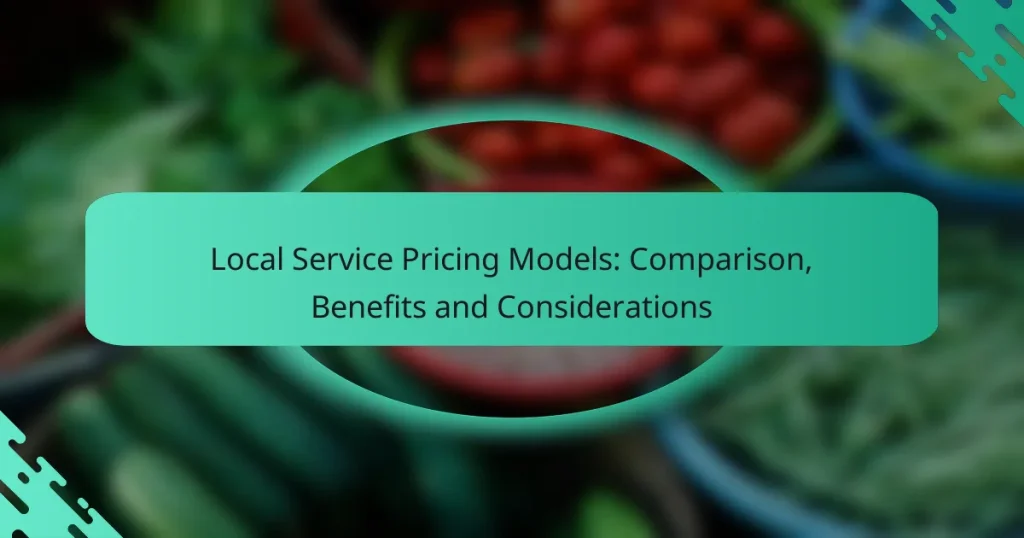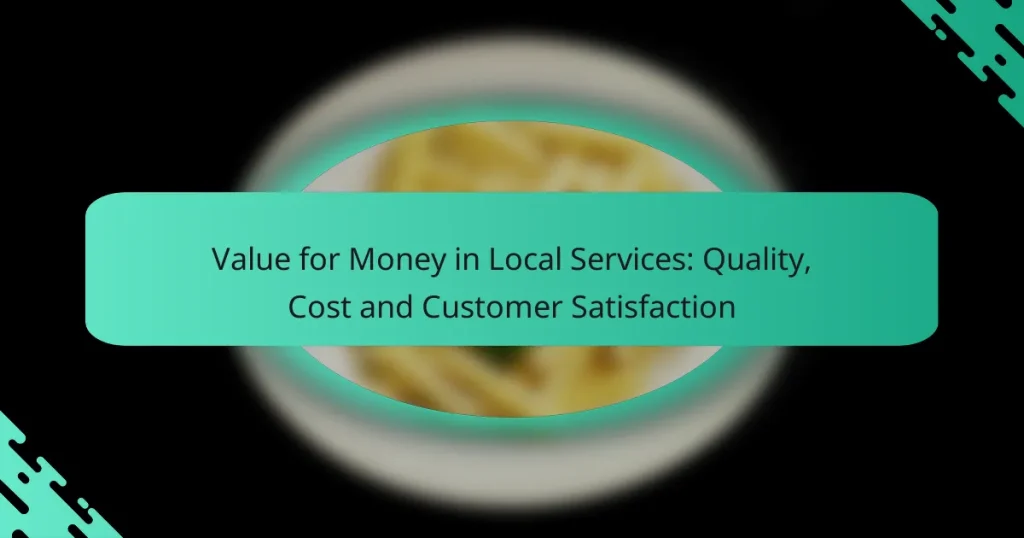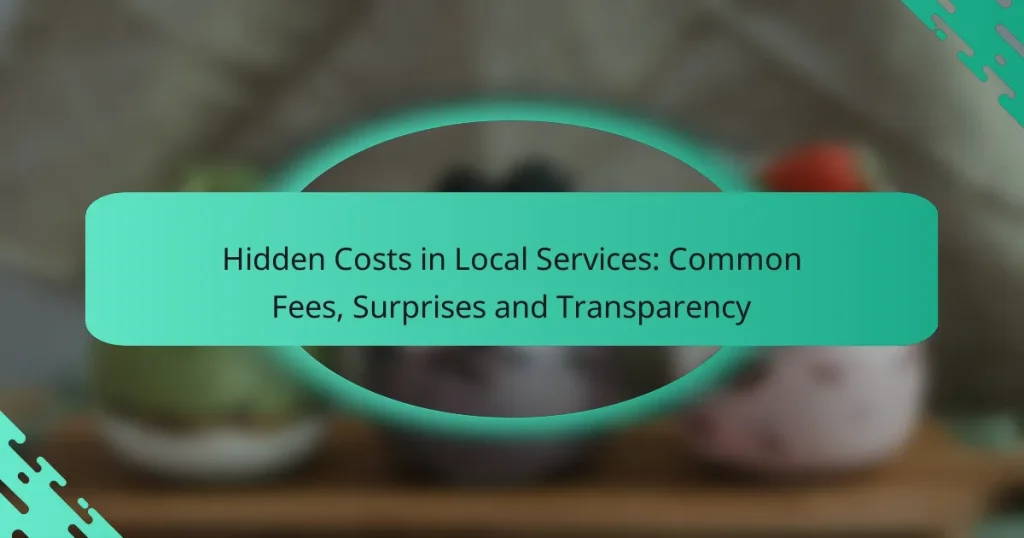Local service providers employ a range of pricing structures, such as hourly rates, flat fees, and subscription models, to cater to diverse consumer needs. By understanding these pricing strategies and the factors influencing them, including market conditions and service complexity, consumers can make informed choices when selecting a provider. This knowledge not only aids in evaluating fairness but also helps service providers remain competitive in their pricing.
Local Service Pricing Models: Comparison, Benefits and Considerations
Value for Money in Local Services: Quality, Cost and Customer Satisfaction
Local Services Budgeting: Expectations, Costs and Variability
Hidden Costs in Local Services: Common Fees, Surprises and Transparency
What are the pricing structures for local service providers?
Local service providers typically utilize various pricing structures to charge for their services, including hourly rates, flat fees, subscription models, and variable pricing based on the type of service offered. Understanding these structures can help consumers make informed decisions when selecting a provider.
Hourly rates
Hourly rates are a common pricing structure where service providers charge clients based on the time spent on a task. Rates can vary significantly depending on the provider’s expertise and the service’s complexity, often ranging from $25 to $150 per hour.
When considering hourly rates, it’s crucial to clarify what the rate includes, such as travel time or materials. Clients should also ask for estimates on how long a job will take to avoid unexpected costs.
Flat fees
Flat fees involve a set price for a specific service, regardless of the time taken to complete it. This structure is often used for straightforward tasks like home cleaning or plumbing repairs, with prices typically ranging from $50 to $500 based on the service type.
Flat fees provide clarity and predictability for clients, making it easier to budget. However, it’s essential to ensure that the scope of work is well-defined to prevent misunderstandings about what is included in the price.
Subscription models
Subscription models allow clients to pay a recurring fee for ongoing services, such as lawn care or maintenance. This structure can range from monthly to annual payments, often providing cost savings for regular users, typically between $20 and $100 per month.
Subscriptions can enhance customer loyalty and ensure consistent service delivery. Clients should evaluate whether the frequency of service justifies the subscription cost and inquire about cancellation policies.
Variable pricing based on service type
Variable pricing based on service type means that costs fluctuate depending on the specific service being provided. For example, a handyman may charge more for electrical work than for general repairs, reflecting the skill level required.
Clients should be aware of these variations and ask for detailed quotes for different services. Understanding the rationale behind pricing can help in negotiating costs and ensuring fair compensation for the provider’s expertise.
How do local service providers determine their pricing?
Local service providers set their pricing based on various factors that reflect market conditions, operational costs, and competitive landscape. Understanding these elements can help consumers gauge the fairness of charges and make informed decisions.
Market demand analysis
Market demand plays a crucial role in pricing strategies for local service providers. When demand is high, providers may increase prices to maximize profits, while lower demand can lead to discounts or promotional offers to attract customers.
Providers often assess demand through customer inquiries, seasonal trends, and regional economic conditions. For instance, landscaping services may charge more during spring and summer when demand peaks.
Cost of materials and labor
The cost of materials and labor directly influences pricing structures for local services. Providers must account for expenses such as supplies, equipment, and wages when determining their rates.
For example, a plumbing service may charge more if the cost of pipes and fittings rises. Additionally, labor costs can vary based on local wage standards, which can affect overall pricing in different regions.
Competitor pricing comparison
Local service providers frequently analyze competitor pricing to remain competitive in their market. By comparing rates, they can adjust their own prices to align with or differentiate from others in the area.
Providers might conduct surveys or use online tools to gather data on what competitors charge for similar services. This information helps them set prices that are attractive to customers while ensuring profitability.
What factors influence pricing for local services in urban areas?
Pricing for local services in urban areas is influenced by several key factors, including service complexity, location and accessibility, and regulatory requirements. Understanding these elements can help consumers make informed decisions and service providers set competitive rates.
Service complexity
The complexity of the service being provided significantly affects pricing. More intricate services, such as specialized repairs or custom installations, typically command higher fees due to the expertise and time required. For instance, a simple plumbing fix may cost around $50 to $150, while a complete bathroom renovation could range from $5,000 to $15,000.
When evaluating service complexity, consider the skill level needed and the time commitment involved. Services that require advanced certifications or specialized tools will generally be priced higher. Always ask for detailed estimates to understand what factors contribute to the total cost.
Location and accessibility
Location and accessibility play crucial roles in determining service pricing. Urban areas often have higher operational costs due to rent, utilities, and transportation, which can lead to increased service fees. For example, a landscaping service in a metropolitan area may charge significantly more than in a rural setting due to these overheads.
Additionally, the ease of access to the service location can impact pricing. If a provider has to navigate difficult traffic or limited parking, they may include extra charges to account for these challenges. Always clarify any location-based fees before agreeing to a service.
Regulatory requirements
Regulatory requirements can also influence pricing for local services. Many urban areas have specific licensing, insurance, and safety regulations that service providers must comply with, which can add to their operational costs. For instance, electricians often need to meet local codes and obtain permits, which can increase the overall price of their services.
Consumers should be aware of these regulations as they can affect both the quality and cost of services. It’s advisable to hire providers who are fully licensed and insured, as this can protect you from potential liabilities and ensure compliance with local laws.
How can customers evaluate the value of local service pricing?
Customers can evaluate the value of local service pricing by considering factors such as service quality, customer feedback, and guarantees offered. Comparing these elements helps determine if the pricing reflects fair value for the services provided.
Customer reviews and testimonials
Customer reviews and testimonials are crucial for assessing the value of local service pricing. They provide insights into the experiences of previous clients, highlighting both strengths and weaknesses of the service provider. Look for patterns in feedback, such as consistent praise for reliability or complaints about delays.
When reading reviews, consider the volume and recency of feedback. A service with numerous positive reviews over time is often more trustworthy than one with only a few recent testimonials. Websites like Yelp or Google Reviews can be valuable resources for gathering this information.
Service guarantees and warranties
Service guarantees and warranties are important indicators of a provider’s confidence in their offerings. A strong guarantee can suggest that the service is reliable and that the provider is willing to rectify any issues that may arise. For example, a local plumbing service might offer a 30-day satisfaction guarantee on their work.
When evaluating service guarantees, check the terms and conditions. Understand what is covered and for how long. This can help you avoid unexpected costs and ensure you receive the quality promised. Additionally, a warranty can provide peace of mind, knowing that you are protected against potential future problems.
What are common pricing models for specific local services?
Local service providers typically use various pricing models, including hourly rates, flat fees, and per-project pricing. The choice of model often depends on the type of service, the complexity of the task, and regional market standards.
Landscaping services pricing
Landscaping services often charge based on the scope of work, with common pricing models including hourly rates or flat fees for specific projects. For example, basic lawn care might range from $30 to $80 per visit, while more complex landscaping projects can cost anywhere from $1,000 to $5,000 or more, depending on materials and labor.
When hiring a landscaper, consider factors such as the size of your yard, the types of plants you want, and any additional features like patios or water features. Always request a detailed estimate to understand what is included in the price.
Plumbing service rates
Plumbing services typically charge either an hourly rate or a flat fee for specific services. Hourly rates can range from $50 to $150, while common tasks like fixing a leaky faucet might have a flat fee of around $100 to $300, depending on the complexity of the issue.
It’s advisable to ask for an estimate before work begins and inquire about any potential additional costs, such as parts or emergency service fees. Keep in mind that rates may vary based on your location and the plumber’s experience.
Home cleaning service fees
Home cleaning services usually charge either by the hour or per square foot, with average hourly rates ranging from $25 to $60. For a standard cleaning of a 1,500 square foot home, costs can vary from $100 to $200, depending on the level of service required.
When hiring a cleaning service, clarify what is included in the cleaning package, such as deep cleaning or special requests. It’s also wise to check for any additional fees for extra services or supplies.
What are the advantages of subscription pricing for local services?
Subscription pricing for local services offers several benefits, including predictable costs and improved customer retention. This model allows customers to pay a set fee regularly, which can simplify budgeting and enhance loyalty to service providers.
Predictable budgeting
Subscription pricing enables customers to anticipate their expenses, making it easier to manage finances. For instance, a monthly cleaning service priced at USD 100 allows customers to allocate that amount in their budget without unexpected costs.
This predictability can be particularly beneficial for households and small businesses that require consistent services, as it helps avoid financial surprises. Customers can plan their spending more effectively, knowing exactly what to expect each month.
Enhanced customer loyalty
Subscription models often foster stronger relationships between service providers and customers. When clients commit to a recurring payment, they are more likely to develop a sense of loyalty and trust towards the service provider, leading to long-term engagement.
Additionally, many providers offer incentives for subscribers, such as discounts or exclusive services, which can further enhance customer satisfaction. This loyalty can translate into referrals and positive reviews, benefiting the business in the competitive local market.




